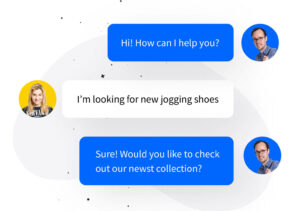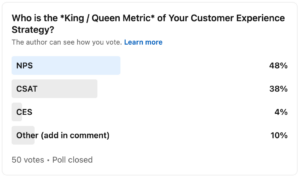5 Ways For Improving Collaboration in Software Teams
Read More

Imagine the internet to be a huge shopping mall. Do you know whose voice would be the loudest in that mall?
Not businesses. Not marketers. It would be that of the customers.
In a business equation, the weight is always in favor of the customers. The cliche statement that “The customer is always right.” …is always right.
Imagine the positive influence a business can have on its bottom line if it can tune into the voice of the customer.
But how? What is the voice of the customer and how can you listen to it?
Voice of the customer – Visualization at various stages
3-step process for data visualization of the voice of customer data.
Channels to capture the voice of the customer
Voice of the Customer (VOC) is made up of two things — experiences and expectations.
VOC is a term that is used to describe the experience and expectations that customers have from a business. It captures their feedback on what they expect from you, what their challenges are, and what their thoughts are on your product or service.
An efficient VOC program helps you identify customer problems and expectations so that you can work on them, improve customer satisfaction and enhance their experience with your brand.
Let’s understand this in a bit more detail!
Be it in business or everyday communication, active listening plays a major role.
Active listening is what results in effective communication and understanding of each other’s perspectives by both sides.
Today, most business communication is virtual. Businesses rarely have the opportunity to meet and greet customers to deliver personalized customer support.
That can lead to unintended communication breakdown.
The Voice of the customer puts into effect an active listening process through which businesses can understand what customers are going through and what needs to be done to meet their expectations ad improve their experience.
If you are still unconvinced, here are some solid reasons why you must conduct an analysis of the voice of customers.
Every business wants to listen to its customers and take corrective measures. The Voice of Customers gives proper insight into what customers feel and sets the management to think in that direction. It could lead to a new product release, a feature update, or even a pricing change that can make the business more appealing to customers.
Irrespective of the good intentions that the business has, it may not be able to deliver what the customer is expecting. This could be because the business is unaware of the real customer expectations.
The Voice of Customers can be used to understand user and client expectations better.
A reduction in customer churn is eventual when the business offerings are in tune with customer expectations. The voice of the customer gives the business many channels through which they can listen to customer opinions and feedback.
Positive reviews and customer testimonials are hard to come by. The voice of the customer creates a consolidated channel where such positive reviews and testimonials can be found. Such reviews can be used on your website, landing pages, mobile app down pages, and other destinations where customer buy-in may have to be sought.
The best products are not always built by businesses. Sometimes customers contribute ideas that can help businesses improve their products. After all, customers know what the product should do, how it solves their problems, and how better it can be.
Ergo, you can learn valuable information by listening to the voice of the customer.
Well, communication is important. And the voice of the customer puts into effect an active listening process through which businesses can understand what customers are going through and what they expect from you.
But why is listening to the customer important? Well, here are a few solid reasons, why you should.
Every business wants to listen to its customers and take corrective measures. The voice of the customer gives proper insight into what customers feel and helps decision makers to update their roadmap in the direction of the customers’ expectations.
It could lead to a new product release, a feature update, or even a pricing change that can make the business more appealing to customers.
When you listen to the voice of the customer, you’ll know what is missing, what it is that your customers aren’t liking, what is the reason for their leaving, and if any more are about to leave.
When you have such insights, you retrospect and fill in the gaps. You work on the problems and give better solutions to the customer so that they don’t leave you. Hence, reducing customer churn.
Positive reviews and customer testimonials are hard to come by. The voice of the customer creates a consolidated channel where such positive reviews and testimonials can be found.
Such reviews can be used on your website, landing pages, mobile app down pages, and other destinations where customer buy-in may have to be sought.
Sharing positive reviews with the team also helps in boosting their motivation so that they feel appreciated for the work they have done. And they focus on providing better and better experiences to their customers.
Do you know how GoPro, the action camera manufacturer manages to nail customer experience with each new product release? They listen to customers through their dedicated community and forums.
These communities, which are co-created by customers, are hyper-active with discussions about hacks for GoPro products, best settings, their pros, cons, and everything under the sun about GoPro.
Incidentally, customers also point out the shortcomings in these products, which GoPro goes on to fix in its upcoming products. The end result?
A strong brand from which competition cannot steal customers. This co-creation with customers has also made GoPro far advanced in product development and innovation.
Like life-long learning, there is no end to customer service improvement. The voice of the customer brings to the surface untold problems and challenges your customers could be facing. It acts as a channel to vent their frustration about something not working properly or a department or service that needs improvement.
Take, for instance, a retail store like IKEA, customers will find it difficult to locate products. They need an assistant to locate it or a guide to take them there. The voice of the customer can expose such intricate shortcomings in customer service that normal customer feedback systems may not provide.
A brand is different from an ordinary business for the additional value it provides. For instance, Apple. There are countless other computing device manufacturers. But Apple stands out from all of them for its immense value in design, features, and customer service. It literally anticipates what customers expect from them and delivers on it.
For businesses that aspire to become the Apple of their industry or sector, the voice of customers helps them with insights into customer behavior. This also enables them to foresee customers’ demands for the near future so that they can start working on it in advance.
Well, isn’t this what Apple does?
The voice of the customer is not just about VOC surveys. Yes, surveys play a critical role in capturing customer feedback, but they offer feedback on the current moment and not the 360-degree viewpoint of the customer.
A customer connects with the brand at multiple touchpoints – website, social media, support call, live chat, email, and many more. While a survey offers you feedback on a specific moment, businesses need to capture data from multiple such touchpoints and more to visualize the 360-degree voice of the customer.
But how to visualize the voice of the customer data?

There are majorly three types of data sources for gathering VOC data and they differ for B2B and B2C.
Social media channels and forums are great examples of indirect VOC data sources. With social listening, you can cater to all this chatter on the web.
Now that you have identified all the VOC data sources, gather them in one place with the help of customer feedback software in one place for analysis.
Now that you have gathered all this data, another challenge at hand is to analyze such complex data. There is too much data to analyze manually, so the best alternative available is text and sentiment analysis.
With machine learning, text analysis reads all thousands of feedback, tags the feedback automatically, and gives you the top trend, say the most common things that customers have talked about, in just a few minutes.
And not just that, sentiment analysis reads this feedback and gives you the top emotions of the customers. For example, if the feedback shared is negative, positive, or neutral in tone.
Now that all the VOC data is analyzed, feedback software like SurveySensum will bring everything to one dashboard. You have all the data in one place to see patterns and make conclusions.
Moreover, you can also slice and dice the data based on your requirements. Such as, a SaaS company would focus on the product features if the newly launched feature is liked by the customer or not. An automotive company would focus on the reviews of the car. An eCommerce brand would focus on how long a customer is browsing or for how long a customer is keeping items in the cart.
Based on each business objective, they can foreground the details based on what they want to see.
So, gauge their customer feedback and take remedial actions that will help the business become customer-centric in the long term.
As discussed, the voice of the customer is not a single touchpoint in the marketing or sales funnel. Instead, it is a culmination of facts gathered from multiple sources or channels.
It is this diverse mode of collecting facts that makes VOC an excellent yardstick for customer satisfaction and loyalty. It ensures that the ultimate understanding of customers is not biased based on a single source and its specific nature.
For example, customer feedback collected through in-app surveys and that collected in-store would vary vastly. However, combining them both to arrive at a common understanding of customers, with the integration of a customer data platform, would be different.
Like in-store and in-app surveys, there are several channels through which VOC can be captured. Some of them are described below:

The oldest trick in the customer service playbook. Customer interviews are direct interactions with customers — online or offline. They aim to capture the customer’s feedback. You can even call it an example of capturing the voice of the customer.
The customer is quizzed on what expectations they had about the product and how their experiences fared against it.
Customer interviews give an elaborate understanding of the customer’s transactions with the business and what occurred at each stage. It is an excellent way to conduct a voice of customer analysis and understand the loopholes in customer service that can be improved in the near future.

Asking for feedback over SMS or email creates a pointless step. The better option is in-app surveys. Why send your customers on another channel when you can take the surveys right there?
While many businesses are mobile-based nowadays, in-app surveys have also become popular amongst them to listen to and better understand the voice of customers. They help businesses gather customer feedback about a specific app feature or service while the customer is using them.

Think of live chat as an all-time available customer support agent. They can provide website visitors with relevant information that helps prevent reliance on support agents. Also, live chat software can segment the queries that customers ask into several segments making it easier to provide contextual customer support.
The live chat is another source of VOC as it gives insights into the most frequently asked questions, frequently posed customer support topics, and even feature asks that can improve the product.

Unlike every other channel, where customer interaction is more or less one-way, in social media, customer interaction is two-way.
Using built-in features that most social media channels like Facebook, Twitter, Instagram, and others offer, it is possible to create polls that capture the voice of the customer. The polls could be everything from customer response to a recently launched marketing campaign, the popularity of an app feature, or even a measure of brand loyalty.
And not just that, your customers are talking about you over social media. So start monitoring the chatter and listen to what they are saying.
Wouldn’t it be great if you are able to capture every single action and interaction that your customers have on your website?
Well, heatmap provides the way for that. Heatmap identifies areas on your websites where there is maximum dwell time, clicks, and other user actions. In short, it highlights website sections where the user spends maximum time.
This gives enough insights into why customers prefer certain sections of a website. And what also needs to be improved in those sections to make it easier for them to find and consume information.
Despite the massive proliferation of live chat, social chatter, and websites, there is still a large chunk of customer interactions that takes place over voice calls.
Phone support is perhaps the favorite of customers since it provides direct and personalized support, it’s a compelling reason for businesses to consider implementing a VoIP phone service. These phone interactions are a gold mine for the voice of customer data and introspection. It enables businesses to sift through call records of customers and spot the most commonly used phrases, customer sentiments while on call, etc., with which they can capture the voice of the customer.
If thoroughly analyzed, VOC can give a business enough insight into how it can improve its services. It focuses on customers’ needs and expectations and helps businesses identify just that!
In a way, it is a ladder to elevate a business from being ordinary to an extraordinary brand.
The voice of customers can help your business in many ways, and some of the benefits include
If you want to make your voice of customers program actionable and generate goal-based engagements, you must follow the following 7 best practices.
Some of the top VoC tools based on their quality, cost-effectiveness, and performance are,
